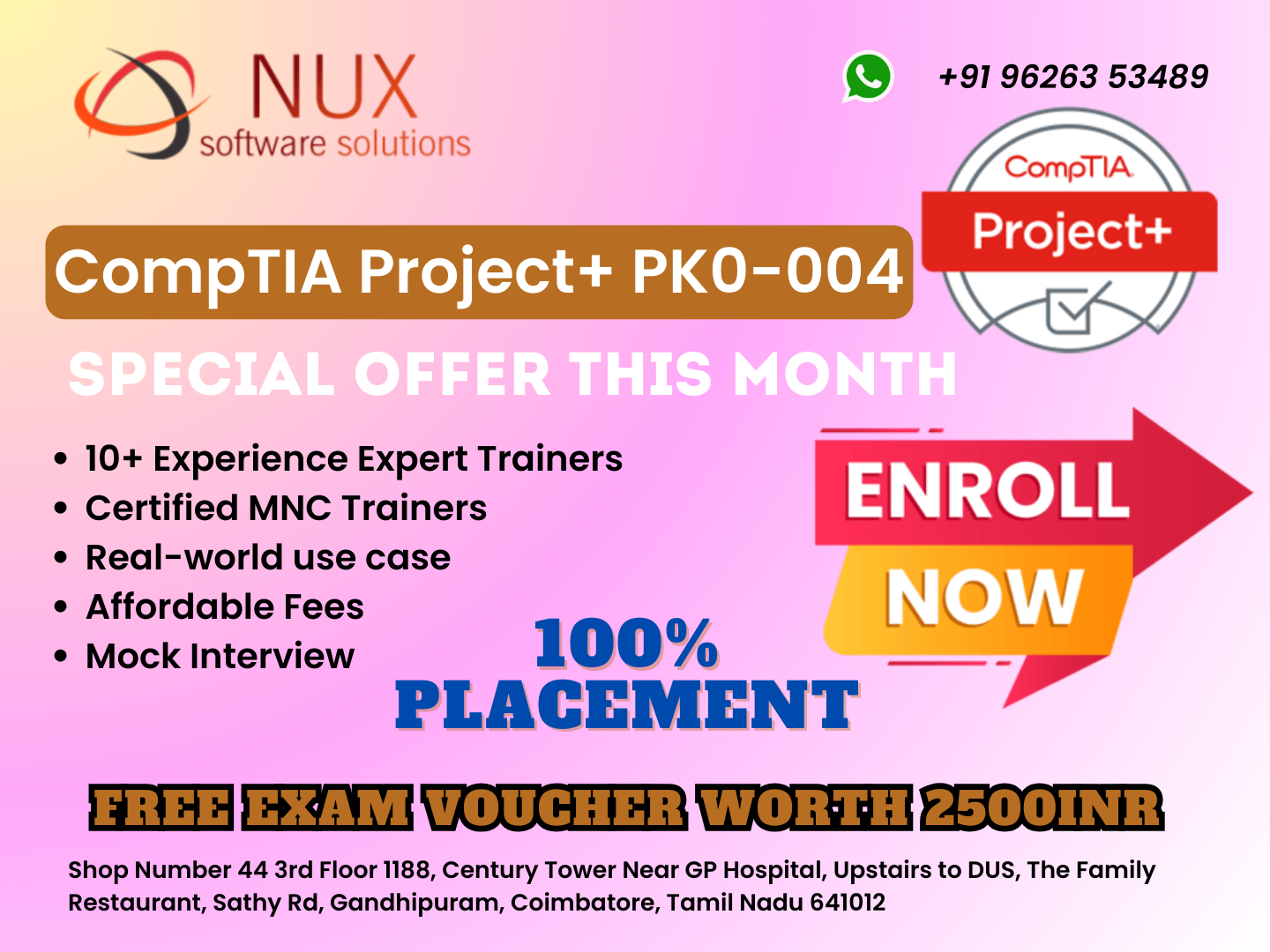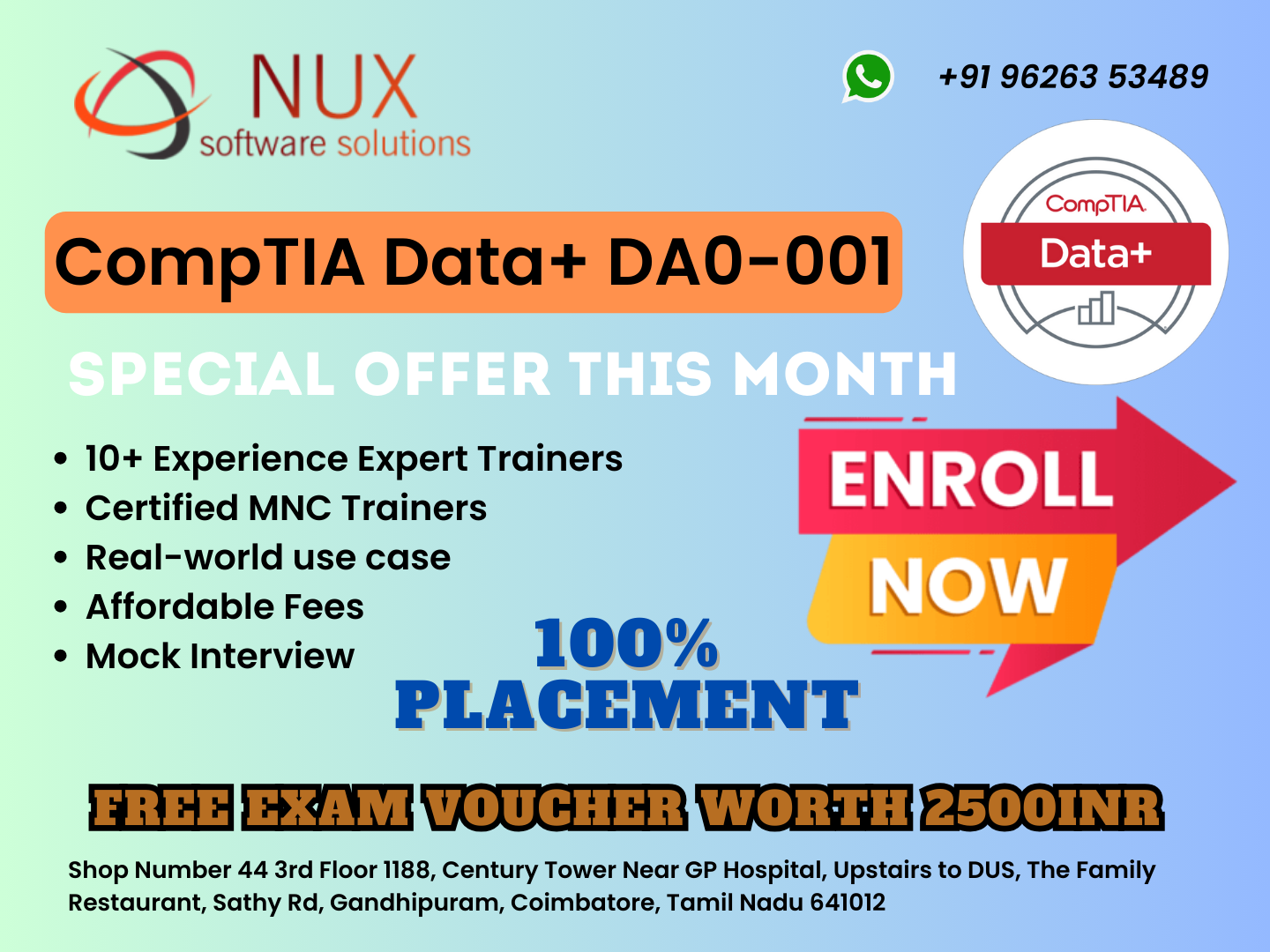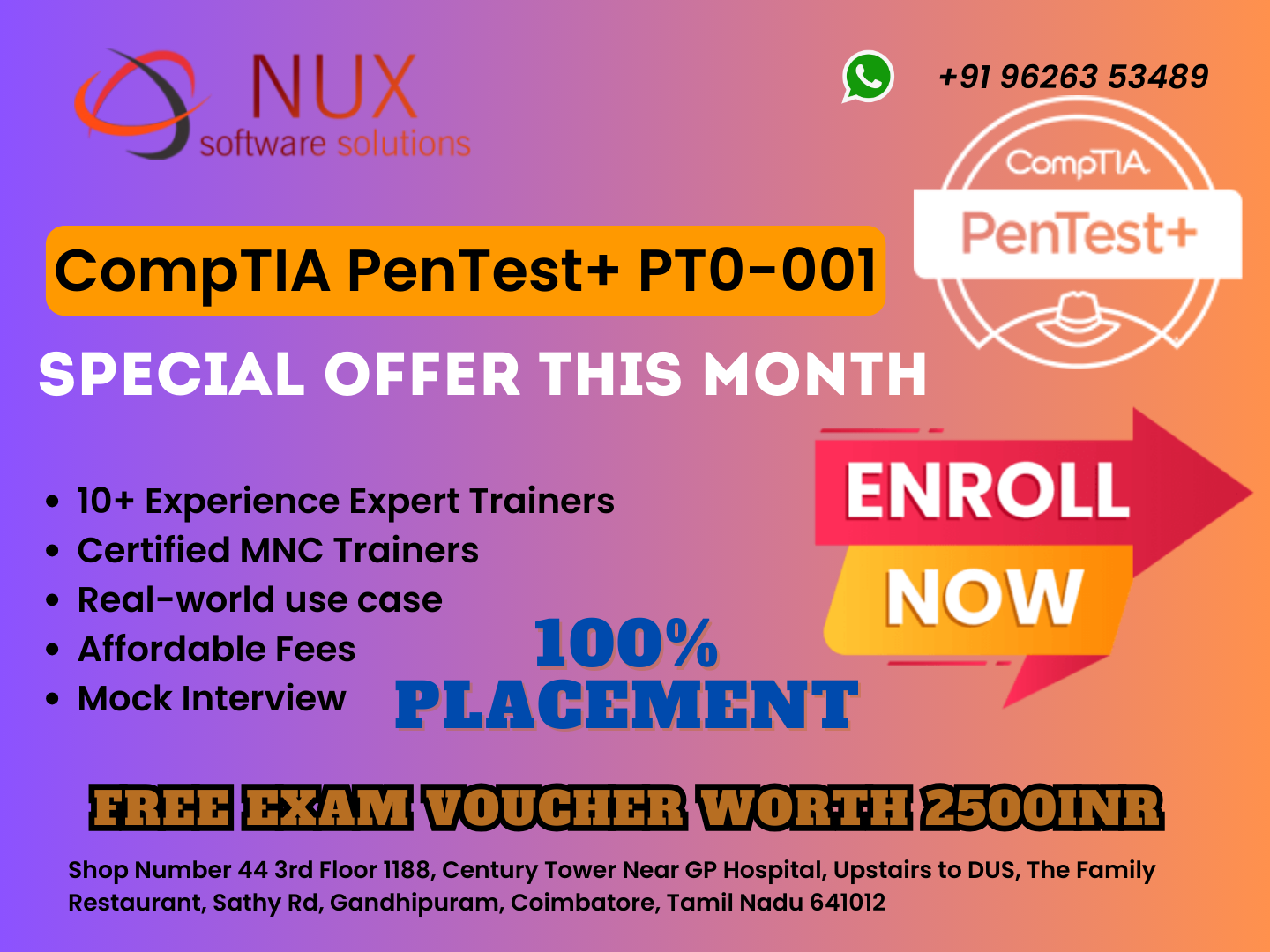CompTIA Project+ PK0-004


NuxSoftware IT Training & Certification Solutions in Coimbatore is your premier choice for CompTIA Project+ PK0-004 training courses. Our advanced programs are meticulously designed to elevate your performance and provide hands-on experience. Industry-leading trainers bring a wealth of skills and experience to the table, covering a diverse range of graded areas.
Our training center offers an exceptional environment suitable for professionals, individuals, corporate entities, and those seeking live project or industrial training. The state-of-the-art lab infrastructure is well-managed, allowing 24/7 access from any location. International expert trainers, equipped with excellent knowledge and real-time industry experience, contribute to a dynamic learning environment.
At Nuxsoftware, we seamlessly integrate innovative learning methods and delivery models into our training programs. Understanding your needs is our priority, ensuring a 100% growth trajectory for your career. Our cost-effective training programs are designed with flexibility to accommodate the unique requirements of our trainees.
The only credential with performance-based items to prove pros can think on their feet to perform critical IT support tasks in the moment.
Employers worldwide rely on our certification to pinpoint the go-to professionals in endpoint management and technical support roles. Continuously refined by IT experts, our certification remains at the forefront, validating the essential skills and abilities demanded in today’s dynamic workplace.
Course Syllabus
CompTIA Project+ PK0-004 Syllabus
Chapters
Project Basics - 36%
- Temporary
- Start and finish
- Unique
- Reason/purpose
- Project as part of a program
- Project as part of a portfolio
- Sponsor/champion, Approval authority, Funding, Project charter, Baseline, High-level requirements, Control, Marketing, Roadblocks, Business case/justification, - Project manager, Manage team, communication, scope, risk, budget, and time, Manage quality assurance, Responsible for artifacts, - Project coordinator, Support project manager, Cross-functional coordination, Documentation/ administrative support, Time/resource scheduling, Check for quality, - Stakeholder, Vested interest, Provide input and requirements, Project steering, Expertise, - Scheduler, Develop and maintain project schedule, Communicate timeline and changes, Reporting schedule performance, Solicit task status from resources, - Project team, Contribute expertise to the project, Contribute deliverables according to schedule, Estimation of task duration, Estimation of costs and dependencies, - Project Management Office (PMO), Sets standards and practices for organization, Sets deliverables, Provides governance, Key performance indicators and parameters, Provides tools, Outlines consequences of non-performance, Standard documentation/templates, Coordinate resources between projects,
- Initiation, Project charter, Business case, High-level scope definition, High-level risks, - Planning, Schedule, Work breakdown structure, Resources, Detailed risks, Requirements, Communication plan, Procurement plan, Change management plan, Budget, - Execution, Deliverables, - Monitor and control, Risks/issues log, Performance measuring and reporting, Quality assurance/governance, Change control, Budget, - Closing, Transition/integration plan, Training, Project sign off, Archive project documents, Lessons learned, Release resources, Close contracts,
- Total project cost, - Expenditure tracking, - Expenditure reporting, - Burn rate, - Cost baseline/budget, Plan vs. actual,
- Functional, Resources reporting to functional manager, Project manager has limited or no authority, - Matrix, Authority is shared between functional managers and project managers, Resources assigned from functional area to project, Project manager authority ranges from weak to strong, - Projectized, Project manager has full authority, Resources report to project manager, Ad hoc resources,
- Work breakdown structure, - Scheduling activities, Determine tasks, Determine task start/finish dates, Determine activity/task durations, Determine milestones, Set predecessors, Set dependencies, Sequence tasks, Prioritize tasks, Determine critical path, Allocate resources, Set baseline, Set quality gates, Set governance gates, Client sign off, Management approval, Legislative approval,
- Readily adapt to new/ changing requirements, - Iterative approach, - Continuous requirements gathering, - Establish a backlog, - Burndown charts, - Continuous feedback, - Sprint planning, - Daily standup meetings/ SCRUM meetings, - SCRUM retrospective, - Self-organized and self-directed teams,
- Resource management concepts, Shared resources, Dedicated resources, Resource allocation, Resource shortage, Resource overallocation, Low quality resources, Benched resources, Interproject dependencies, Interproject resource contention, - Personnel management, Team building, Trust building, Team selection, Skill sets, Remote vs. in-house, Personnel removal/replacement, Communication issues, Conflict resolution, Smoothing, Forcing, Compromising, Confronting, Avoiding, Negotiating,
Project Constraints - 17%
- Common constraints, Budget, Scope, Deliverables, Quality, Environment, Resources, Requirements, Scheduling, - Influences, Change request, Scope creep, Constraint reprioritization, Interaction between constraints, Stakeholders/sponsors/management, Other projects,
- Strategies, Accept, Mitigate, Transfer, Avoid, Exploit, - Risk activities, Identification, Quantification, Planning, Review, Response, Register, Prioritization, Communication,
Communication & Change Management - 26%
- Meetings, Kick-off meetings, Virtual vs. in-person meetings, Scheduled vs. impromptu meetings, Closure meetings, - Email, - Fax, - Instant messaging, - Video conferencing, - Voice conferencing, - Face-to-face, - Text message, - Distribution of printed media, - Social media,
- Language barriers, - Time zones/geographical factors, - Technological factors, - Cultural differences, - Interorganizational differences, - Intraorganizational differences, - Personal preferences, - Rapport building/relationship building, - Tailor method based on content of message, - Criticality factors, - Specific stakeholder communication requirements, Frequency, Level of report detail, Types of communication, Confidentiality constraints, Tailor communication style,
- Audits, - Project planning, - Project change, - Risk register updates, - Milestones, - Schedule changes, - Task initiation/completion, - Stakeholder changes, - Gate reviews, - Business continuity response, - Incident response, - Resource changes,
- Change control process, Identify and document, Evaluate impact and justification, Regression plan (Reverse changes), Identify approval authority, Obtain approval, Implement change, Validate change/quality check, Update documents/audit documents/version control, Communicate throughout as needed, - Types of common project changes, Timeline change, Funding change, Risk event, Requirements change, Quality change, Resource change, Scope change,
- Business merger/acquisition, - Business demerger/split, - Business process change, - Internal reorganization, - Relocation 6. Outsourcing,
Project Tools & Documentation - 21%
- Project scheduling software, - Charts, Process diagram, Histogram, Fishbone, Pareto chart, Run chart, Scatter chart, Gantt chart, - Dashboard/status report, - Knowledge management tools, Intranet sites, Internet sites, Wiki pages, Vendor knowledge bases, Collaboration tools, - Performance measurement tools, Key performance indicators, Key performance parameters, Balanced score card, - SWOT analysis, - Responsible, Accountable, Consulted, Informed (RACI) Matrix,
- Project charter, - Project management plan, - Issues log, - Organizational chart, - Scope statement, - Communication plan, - Project schedule, - Status report, - Dashboard information, - Action items, - Meeting agenda/meeting minutes,
- Request for Information, - Request for Proposal, - Request for Quote, - Mutually binding documents, Agreements/contract, Non-disclosure agreement, Cease and Desist letter, Letter of Intent, Statement of Work, Memorandum of Understanding, Service Level Agreement, Purchase Order, Warranty,


